5. MITOTIC CELL CYCLE
1/67
There's no tags or description
Looks like no tags are added yet.
Name | Mastery | Learn | Test | Matching | Spaced |
|---|
No study sessions yet.
68 Terms
What is the role of DNA in the structure of a chromosome?
DNA (Deoxyribonucleic Acid) is the molecule that carries genetic information in the form of a sequence of genes.
It replicates during interphase (S phase) to create identical strands, forming chromatids.
It is a long, double-helical structure made up of nucleotides.
In chromosomes, DNA is tightly coiled and folded to fit within the nucleus.
The sequence of bases in DNA determines the genetic instructions for the organism.
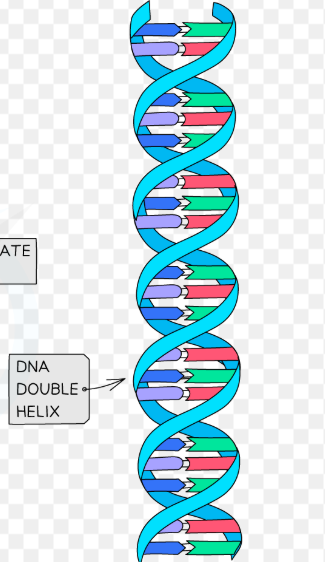
What are histone proteins and their role in chromosomes?
Histone proteins are large, positively charged proteins around which DNA is wrapped.
They help organize and condense DNA into a compact structure called chromatin. DNA coils around histones to form chromatin.
This packaging allows the long DNA molecule to fit into the nucleus and protects it from damage.
Histones also play a role in regulating gene expression by controlling access to DNA.
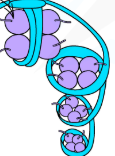
What role do histones play beyond condensing DNA?
Histones not only condense DNA but also protect it from damage by organizing it into a stable structure, ensuring its functionality during replication and transcription.
What is chromatin, and how does it relate to chromatids and chromosomes?
Chromatin is the tightly coiled combination of DNA and histone proteins. Chromatin forms chromatids, which combine to make chromosomes.
What are sister chromatids, and why must they be identical?
Sister chromatids are two identical strands of DNA joined by a centromere. Their identical nature is crucial for mitosis, ensuring that daughter cells are genetically identical.
What is the centromere and its function?
The centromere is a constricted (narrow) region of the chromosome that holds the sister chromatids together.
It is essential for the proper alignment and separation of chromosomes during cell division.
The centromere is also the attachment site for spindle fibers, which pull the chromatids apart.

What are telomeres and their significance?
Telomeres are repetitive DNA sequences located at the ends of chromosomes.
They protect the chromosome ends from degradation and prevent them from fusing with other chromosomes.
Telomeres shorten with each cell division, which is associated with aging and cell lifespan

Why is it necessary for sister chromatids to be identical?
It is important that the sister chromatids are identical (contain the same genes) because this is key to cell division, as one chromatid goes into one daughter cell and one goes into the other daughter cell during mitosis, ensuring the daughter cells are genetically identical
Full structure of chromosomes
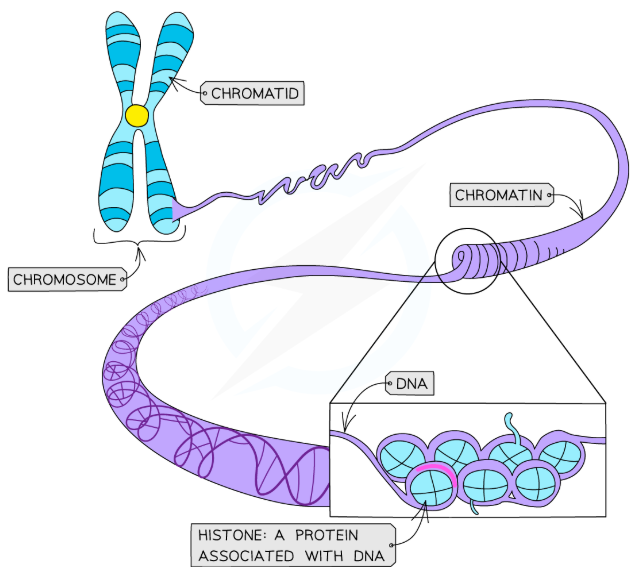
What is the cell cycle and why is it important?
The cell cycle is the regulated sequence of events that occurs between one cell division and the next.
It ensures proper growth, DNA replication, and division to produce genetically identical cells.
It consists of three main phases:
Interphase (cell growth and DNA replication).
Mitosis (nuclear division).
Cytokinesis (cell division).
Example: Onion root tip cells divide approximately every 20 hours; human intestinal epithelial cells every 10 hours.
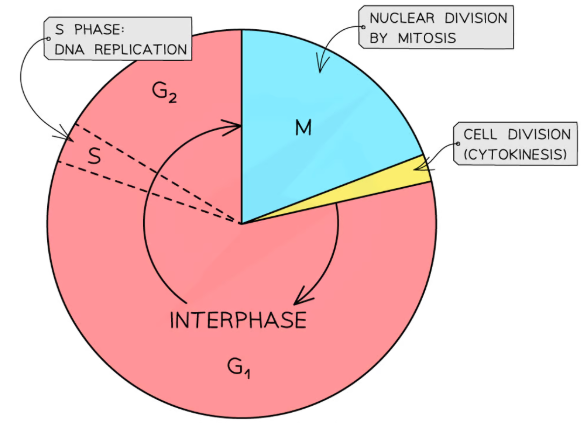
What is mitosis, and why is it significant?
Mitosis is the process of nuclear division that produces two genetically identical daughter nuclei. This ensures genetic continuity, vital for growth, repair, replacement of cells, and asexual reproduction.
How does mitosis contribute to the growth of multicellular organisms?
Mitosis produces genetically identical daughter cells, enabling unicellular zygotes to grow into multicellular organisms. Growth may occur across the body or in specific regions (e.g., meristems in plants).
Why is mitosis important for cell replacement?
Mitosis replaces dead or damaged cells with genetically identical ones, ensuring tissue function. For example, human skin and gut lining cells are rapidly replaced via mitosis.
What role does mitosis play in tissue repair?
Damaged tissues are repaired through mitosis and subsequent cell division. This ensures that new cells are genetically identical, maintaining the tissue's structure and function.
Why is mitosis crucial in asexual reproduction?
In asexual reproduction, mitosis enables the production of offspring genetically identical to the parent. Examples include:
Unicellular organisms like Amoeba producing clones.
Multicellular plants (e.g., strawberries producing runners).
Budding in organisms like Hydra and yeast.
Where does mitosis occur most rapidly in humans, and why?
Mitosis occurs rapidly in areas like the skin and gut lining to replace cells lost through wear and tear, ensuring these tissues maintain their function and integrity.
Can mitosis aid in regeneration? Provide examples.
Yes, some animals use mitosis to regenerate body parts. For instance:
Zebrafish can regenerate fins.
Axolotls can regenerate legs and tails.
How does mitosis ensure genetic consistency?
Mitosis produces daughter cells that are exact genetic copies of the parent cell. This consistency is vital for maintaining an organism's genetic integrity.
What is a common exam pitfall related to mitosis terminology?
Avoid saying "damaged cells are repaired." Instead, describe how dead or damaged cells are replaced with new, identical cells.
How is mitosis critical for plant growth?
In plants, mitosis occurs at meristems (growth points), enabling plants to grow in height or girth. The cells produced are genetically identical, ensuring consistent growth.
Provide an example of asexual reproduction in plants.
Runners in strawberry plants grow new genetically identical plants. These clones detach from the parent plant to form independent individuals.
What are the key features that make mitosis unique?
Key features include:
Production of genetically identical daughter cells.
Maintenance of chromosome number across cell generations.
Vital roles in growth, repair, and reproduction.
What is the cell cycle, and what are its phases?
The cell cycle is a regulated sequence of events between cell divisions. It consists of:
Interphase (G1, S, and G2 phases)
Mitosis (nuclear division)
Cytokinesis (cell division)
The cycle duration varies by cell type and environmental conditions. Cyclins are chemical signals that regulate phase transitions.
What happens during the G1 phase of interphase?
In the G1 phase:
The cell grows in mass and size.
RNA, enzymes, and proteins essential for growth are synthesized.
The cell prepares for DNA replication and receives signals for division.
What occurs during the S phase of interphase?
During the S (synthesis) phase:
DNA replication takes place.
Each chromosome forms two identical sister chromatids joined at a centromere.
This phase is relatively short but critical.
What happens during the G2 phase of interphase?
In the G2 phase:
The cell continues growing.
Newly synthesized DNA is checked for errors and repaired.
Preparations for cell division occur (e.g., production of tubulin for the mitotic spindle).
What is mitosis, and what happens during the M phase?
Mitosis (M phase) is the nuclear division phase:
The nucleus divides to form two genetically identical nuclei.
Cell growth halts during this phase.
Chromosomes align, separate, and are pulled into each nucleus.
What is cytokinesis, and how does it differ in plant and animal cells?
Cytokinesis follows mitosis:
The cytoplasm divides, forming two genetically identical daughter cells.
In animal cells: The cytoplasm constricts between the two nuclei.
In plant cells: A new cell wall forms between the two nuclei.
What is the relationship between G1, S, and G2 phases in interphase?
Interphase is the combination of:
G1 Phase: Cell growth and preparation for DNA replication.
S Phase: DNA replication occurs.
G2 Phase: Growth continues, DNA is checked, and division preparation takes place.
What role do cyclins play in the cell cycle?
Cyclins are chemical signals that trigger phase transitions in the cell cycle, ensuring orderly progression from interphase to mitosis and cytokinesis.
How does the duration of the cell cycle vary?
The cell cycle duration depends on environmental conditions, cell type, and organism:
Onion root tip cells: ~20 hours.
Human intestine epithelial cells: ~10 hours.
What common interphase-related exam question should you be prepared for?
Be ready to identify the cell cycle phase where the most mRNA molecules are produced (G1 phase). This is when protein synthesis, involving transcription (mRNA production), occurs.
What are telomeres, and what are they made of?
Telomeres are protective structures at the ends of chromatids. They consist of non-coding DNA made up of multiple repeated base sequences:
One strand is guanine-rich (G), and the other is cytosine-rich (C).
These sequences do not code for proteins but play a vital protective role.
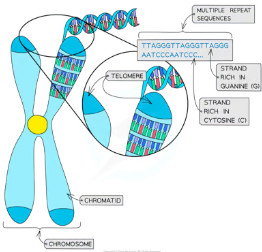
How do telomeres prevent gene loss during DNA replication?
The enzyme responsible for DNA replication cannot copy the very end of DNA molecules, stopping short of the ends. Telomeres act as a buffer region:
They ensure no vital genes are lost during replication.
By being non-essential DNA, telomeres safeguard important coding regions near DNA ends.
What happens to telomeres during cell division?
During each cell division, telomeres shorten slightly. If genes were located at the ends of DNA, they would be lost during replication. Telomeres prevent this, allowing cells to divide without losing critical genetic information.
What is telomerase, and why is it important?
Telomerase is an enzyme that adds extra base sequences to the ends of telomeres:
This "topping up" prevents excessive telomere shortening.
Telomerase is active in most cells, enabling continued cell replication.
What is the connection between telomeres, specialised cells, and ageing?
Specialised cells often lack telomerase, meaning their telomeres are not replenished:
After a finite number of divisions, telomeres become too short, leading to cell death.
This process is linked to ageing.
Why are telomeres crucial for cellular replication? Back: Telomeres
Telomeres:
Protect coding regions from being lost during DNA replication.
Prevent loss of vital genes across multiple cell divisions.
Enable cells to maintain genetic integrity during mitosis.
How are telomeres similar to and different from coding DNA?
Similarity: Telomeres are made of the same nucleotides (A, T, C, G). Difference: Telomeres are non-coding—they do not code for proteins but serve as protective buffers.
What are stem cells, and what makes them unique?
Stem cells are cells that can divide (by mitosis) an unlimited number of times. They have the ability to either remain as stem cells or differentiate into specialized cells (e.g., blood or muscle cells).
What is differentiation and potency in stem cells?
Differentiation is the process where stem cells develop into specialized cell types. Potency refers to their ability to differentiate:
Totipotency: Can form any embryonic or extra-embryonic cell type (e.g., zygote up to 16-cell stage).
Pluripotency: Can form any embryonic cell type but not extra-embryonic cells.
Multipotency: Adult stem cells that form a limited range of specialized cells.
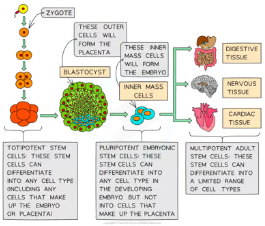
How do stem cells contribute to tissue development and specialization?
As tissues, organs, and systems develop, cells specialize for particular roles. Adult stem cells remain in small numbers to allow growth, cell replacement, and tissue repair throughout life.
What are multipotent adult stem cells, and where are they found?
Multipotent stem cells divide indefinitely but produce limited cell types. Examples include:
Bone marrow stem cells: Can form blood cells like red blood cells, monocytes, neutrophils, and lymphocytes.
Found in various locations (e.g., bone marrow, skin, gut, heart, brain).
How do stem cells aid in cell replacement and tissue repair?
Stem cells divide (by mitosis) to produce new cells for growth, replacing dead or damaged cells and repairing tissues. This is critical for maintaining healthy, functional organs.
What is stem cell therapy, and how is it used?
Stem cell therapy introduces adult stem cells into damaged tissue to treat diseases (e.g., leukemia) or injuries (e.g., skin burns). This leverages stem cells’ ability to regenerate and repair.
How are stem cells linked to aging?
Adult stem cells often lose potency over time. Specialized cells that lack division ability eventually die, contributing to the aging process.
What is a common exam pitfall related to stem cells?
Remember that multipotent adult stem cells produce a limited range of cell types. For example, bone marrow stem cells can only form blood cell types, not other specialized cells.
What is uncontrolled cell division, and how does it lead to tumour formation?
Uncontrolled cell division occurs due to mutations in genes regulating mitosis. Cancerous cells divide repeatedly, forming a tumour (an irregular mass of cells). These mutations prevent early cell death or immune system destruction, allowing harmful mutations to be passed to descendant cells.
What role do mutations and oncogenes play in tumour formation?
Mutations in genes controlling cell division can lead to cancer. If the mutated gene causes cancer, it is called an oncogene. While most mutations are harmless, those that evade cell death or immune destruction result in cancerous cells.
What are the two main types of tumours, and how do they differ?
Benign Tumours: Do not spread from their original site and are non-cancerous (e.g., warts).
Malignant Tumours: Spread through the body, invading and destroying tissues, causing cancer. Malignant cells can travel via blood or lymphatic systems, forming secondary growths (metastasis).
What are carcinogens, and how do they contribute to tumour formation?
Carcinogens are agents that cause cancer (e.g., UV light, tar in tobacco smoke, X-rays). They induce mutations in genes controlling cell division, leading to uncontrolled mitosis and tumour formation.
What is metastasis, and why is it dangerous?
Metastasis is the spread of malignant tumour cells to other parts of the body via blood or lymphatic systems. Secondary tumours formed through metastasis are difficult to detect, locate, and remove, making cancer treatment challenging.
How do malignant tumours affect the body?
Malignant tumours interfere with normal organ/tissue functions by:
Blocking intestines, lungs, or blood vessels.
Invading and destroying surrounding tissues.
Forming secondary tumours through metastasis.
Provide examples of carcinogens that can lead to cancer.
Examples include:
UV light.
Tar in tobacco smoke.
X-rays.
Oncoviruses (viruses that cause cancer).
What are the stages in the development of cancer?
Mutation in genes controlling cell division.
Formation of a tumour due to uncontrolled mitosis.
Growth of malignant tumours, invading tissues.
Metastasis, spreading cancer to other body parts.
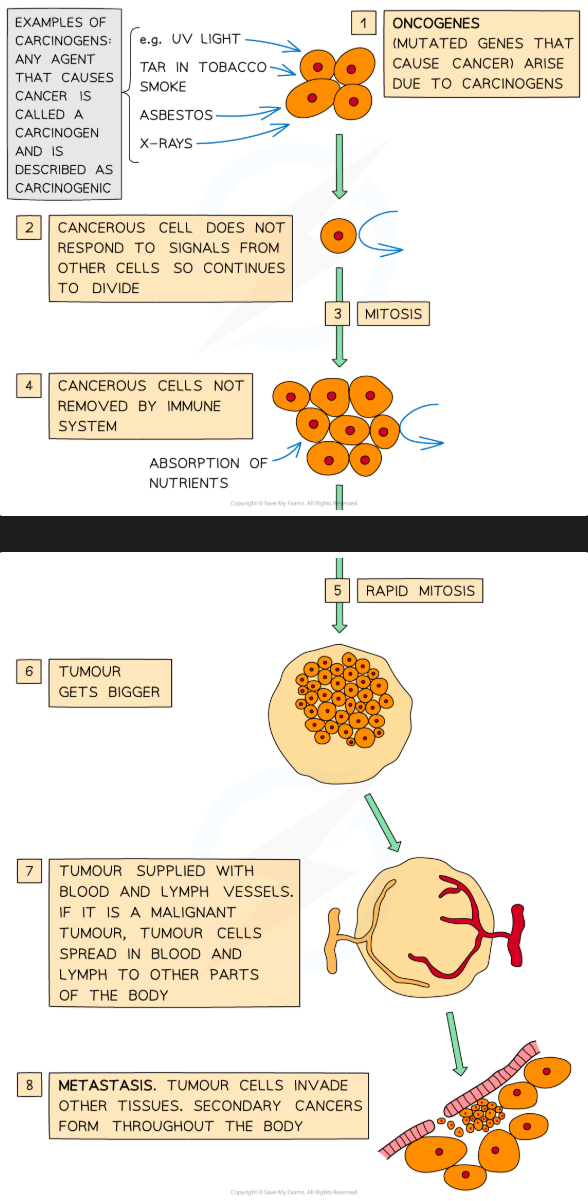
What is mitosis, and why is it important?
Mitosis is the process of nuclear division that produces two genetically identical daughter nuclei with the same chromosome number as the parent cell. It's crucial for growth, repair, and asexual reproduction.
What are the main stages of mitosis?
The four main stages are
Prophase
Metaphase
Anaphase
Telophase
(PMAT)
What happens to chromosomes during Prophase?
Chromosomes condense and become visible. They appear as sister chromatids joined at the centromere. Centrosomes move to opposite poles, spindle fibers start forming, and the nuclear envelope breaks down.

What happens to the nuclear envelope during Prophase?
The nuclear envelope disintegrates into vesicles, allowing spindle fibers to interact with chromosomes.
What is the behavior of chromosomes and spindle fibers in Metaphase?
Chromosomes align at the equator (metaphase plate). Spindle fibers attach to centromeres, ensuring sister chromatids face opposite poles.
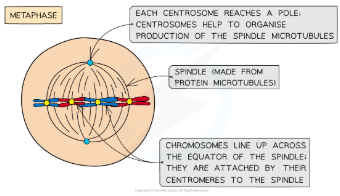
Describe the movement of chromosomes in Anaphase.
Sister chromatids separate at the centromeres. Spindle fibers shorten, pulling chromatids (now individual chromosomes) to opposite poles.

What changes occur during Telophase?
Chromosomes decondense at opposite poles. Nuclear envelopes reform around each chromosome set, and spindle fibers disassemble.
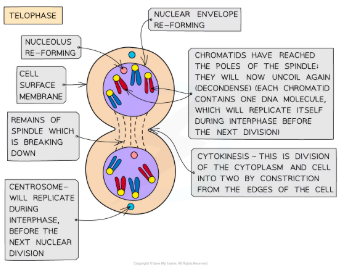
What is the role of spindle fibers during mitosis?
Spindle fibers (microtubules) attach to chromosome centromeres, ensuring chromatids are pulled to opposite poles.
How many chromosomes and DNA molecules are in a human cell during mitosis?
Before mitosis, there are 92 DNA molecules (46 chromosomes replicated into sister chromatids). After mitosis, each daughter cell has 46 chromosomes.
What are the main differences in mitosis between plant and animal cells?
Animal Cells: Have centrioles to organize spindle fibers. Cytokinesis occurs by membrane pinching.
Plant Cells: Lack centrioles; spindle fibers form differently. Cytokinesis occurs via a cell plate.
Why are root tips used for observing mitosis?
Root tips contain meristems, where active cell division occurs. This makes them ideal for studying mitosis.
What is crucial when analyzing micrographs for mitosis?
Be able to identify each stage of mitosis based on the arrangement of chromosomes and explain why the cell is in that stage.
What is the role of meristems in plant growth?
Meristems are regions of active cell division, contributing to growth in roots and shoots.